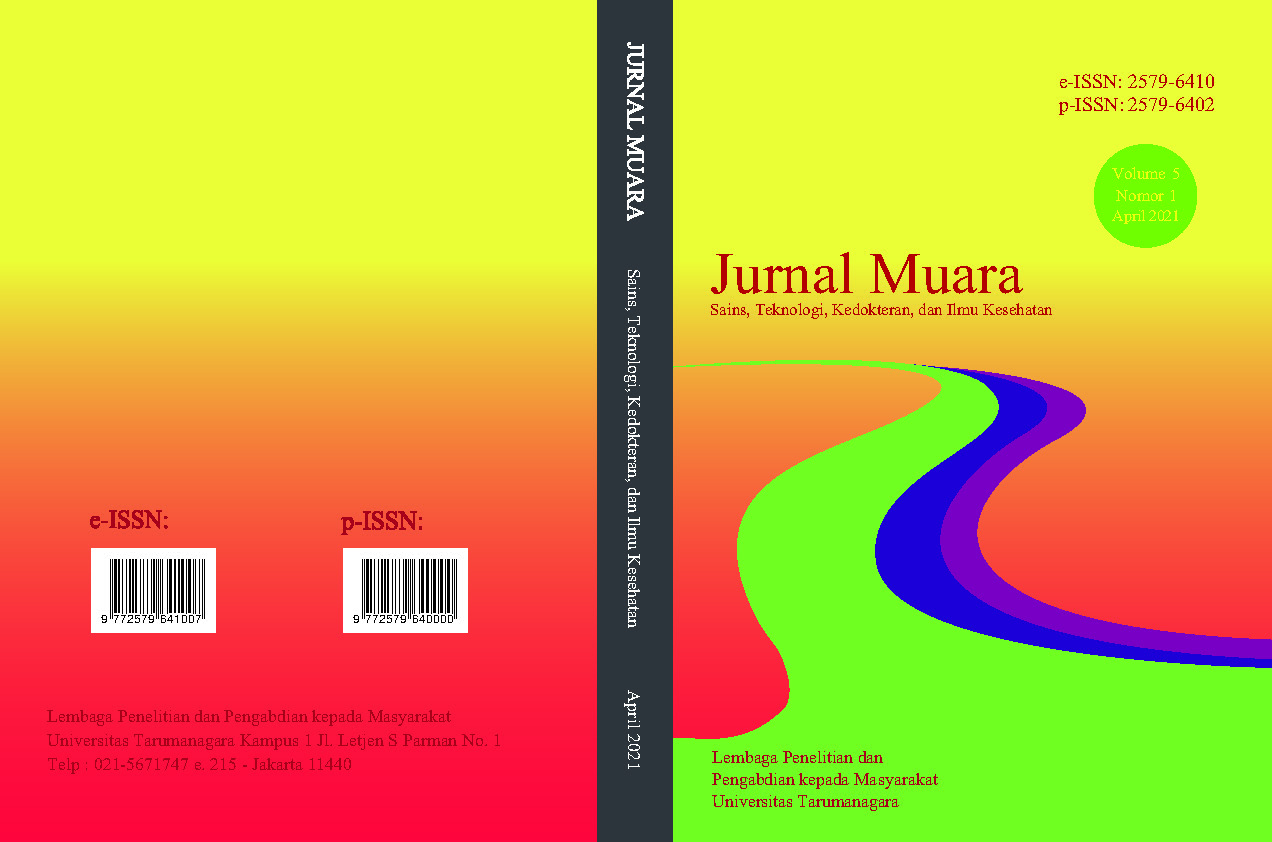HUBUNGAN ANTARA DIABETES MELLITUS TIPE II DENGAN DERAJAT OSTEOARTHRITIS LUTUT
Main Article Content
Abstract
Osteoarthritis is a degenerative disease that cause damage to joint cartilage damage. Osteoarthritis affects 151,4 million people in the world, including 27,4 million in Southeast Asia. Osteoarthritis is a disease that is a burden on public health and the country. The prevalence of osteoarthritis is one in four people aged 50 years and individuals aged 65 years are more at risk of developing calcification of the knee joint. Risk factors such as type II Diabetes Mellitus are observed in one of osteoarthritis research. A hispanic study explained the prevalence of osteoarthritis patient are twice as much in diabetic patient than non-diabetic patient. A score of 6.5% of HbA1c test is required to diagnose diabetes. The goal of this study is to find out the connection of type 2 diabetes mellitus and knee osteoarthritis. This research uses observational analytic with cross sectional research design with a total of 45 patient from Orthopedic clinic of Al – Fauzan General Hospital in 2016 – 2019 and analyzed with chi square test. According to the result, the most group of age is elderly about 34 people (75,6%), the most group of gender is women about 34 people (75,6%), the most group of HbA1c is non-diabetes mellitus group about 30 people (66,7%), the most group of osteoarthritis stage is severe de (4) about 28 people (62,2%), and there is no connection between type II diabetes mellitus with the stage of knee osteoarthritis with p value of 0,828 (p > 0.05). this research shows no significant correlation between type II diabetes mellitus and the stage of knee osteoarthritis.
Keywords : Knee Osteoarthritis; HbA1c; Type II Diabetes Mellitus
Abstrak
Osteoarthritis adalah penyakit degeneratif yang disebabkan kerusakan tulang rawan sendi. Osteoarthritis dialami 151,4 juta orang di dunia dan 27,4 juta orang di Asia Tenggara. Osteoarthritis merupakan penyakit yang menjadi beban kesehatan masyarakat dan negara. Prevalensi terjadinya osteoarthritis yaitu satu dari empat orang berusia 50 tahun dan individu berusia lebih dari 65 tahun beresiko mengalami pengapuran sendi lutut. Penelitian osteoarthritis mengamati faktor risiko terjadinya osteoarthritis seperti diabetes mellitus tipe 2. Studi Hispanik menjelaskan prevalensi penderita osteoarthritis dua kali lebih banyak terjadi pada penderita dengan diabetes dibandingkan penderita tanpa diabetes. Pemeriksaan HbA1c direkomendasikan untuk mendiagnosis diabetes, dengan batas nilai 6,5 %. Tujuan penelitian ini adalah untuk mengetahui hubungan antara diabetes mellitus tipe II dengan derajat osteoarthritis lutut. Penelitian ini menggunakan analitik observasional dengan desain penelitian potong lintang dengan jumlah sampel 45 pasien di Poli Orthopedi Rumah Sakit Umum Al – Fauzan tahun 2016 – 2019 dan dianalisa menggunakan uji kai kuadrat. Berdasarkan hasil penelitian, usia terbanyak adalah lansia yaitu 34 orang (75,6 %), jenis kelamin terbanyak adalah perempuan yaitu 34 orang (75,6 %), HbA1c terbanyak adalah non diabetes mellitus yaitu 30 orang (66,7 %), derajat osteoarthritis lutut terbanyak adalah derajat berat (4) yaitu 28 orang (62,2 %), dan tidak terdapat hubungan yang bermakna antara diabetes mellitus tipe II dengan derajat osteoarthritis lutut dengan nilai p sebesar 0,828 (p > 0,05). Penelitian ini menunjukan tidak terdapat hubungan yang bermakna antara diabetes mellitus tipe II dengan derajat osteoarthritis lutut
Article Details
This work is licensed under a Jurnal Muara Sains, Teknologi, Kedokteran dan Ilmu Kesehatan Creative Commons Attribution-ShareAlike 4.0 International License.
Authors transfer copyright or assign exclusive rights to the publisher (including commercial rights)
References
Ali, SJ. (2017). Hubungan Antara Derajat Radiologi Menurut Kellgren Dan Lawrence Dengan Tingkat Nyeri Pada Pasien Osteoarthritis Genu Di RS.Universitas Hassanuddin. Skripsi Universitas Hasanuddin
American Diabetes Association. (2014). Diagnosis and Classification of Diabetes Mellitus. Diabetes Care, 37(1), 81 – 90.
Burner T.W, Rosenthal A.K. (2009). Diabetes and rheumatic diseases. Curr Opin Rheumatol. 21(1), 50-4. doi: 10.1097/BOR.0b013e32831bc0c4
Chen, L. Magliano, DJ. & Zimmet, PZ. (2012). The worldwide epidemiology of type 2 diabetes mellitus – present and future perspectives. Nature Reviews Endocrinology, 8(4), 228 – 236.
Hunter, DJ. & Zeinstra, SB. (2019). Osteoarthritis. The Lancet, 393(10182), 1745 – 1759.
Johnson, VL. & Hunter, DJ. (2014). The epidemiology of osteoarthritis. Best Practice & Research Clinical Rheumatology, 28(1), 5 – 15.
Louati, K. Vidal, C. Berenbaum, F. & Sellam, J. (2015). Association between diabetes mellitus and osteoarthritis : systematic literature review and meta analysis. RMD Open, 1(1), 1 – 10.
Nieves Plaza, M. Castro Santana, LE. et al. (2013). Association of Hand or Knee Osteoarthritis With Diabetes Mellitus in a Population of Hispanics From Puerto Rico. JCR : Journal of Clinical Rheumatology, 19(1), 1 – 6.
Piva, SR. Susko, AM. Khoja, SS. et al. (2015). Links Between Osteoarthritis and Diabetes : Implications for Management from a Physical Activity Perspective. Clinics in Geriatric Medicine, 31(1), 67 – 87.
Sastroasmoro, S. & Ismael, S. (2014). Dasar – Dasar Metodologi Penelitian Klinis. Sagung Seto, Jakarta.
Shin, D. (2014). Association Between Metabolic Syndrome, Radiographic Knee Osteoarthritis, and Intensity of Knee Pain : Results of a National Survey. The Journal Of Clinical Endocrinology & Metabolism, 99(9), 3177 – 3183.
Sturmer, T. Brenner, H. Brenner, RE. & Gunther, KP. (2001). Non – Insulin Dependent Diabetes Mellitus (NIDDM) and Patterns of Osteoarthritis. Scandinavian Journal of Rheumatology, 30(3), 169 – 171.
Supartono, B. (2017). Bunga Rampai Kedokteran Olahraga. Pusat Kajian Stem Cell Fakultas Kedokteran Universitas Pembangunan Nasional “Veteran” Jakarta, Jakarta.
Supartono, B. Amalia, R. Satya, I. & Wiyono, S. (2018). Relation Between Osteoarthritis Grading Scale with Cartilage Ultrasonographic in Knee Osteoarthritis Patient at RSU Al Fauzan Period of 2016 – 2017. Journal of Medical - Clinical Research & Reviews, 2(6), 1 – 4.
Supartono, B. Ismail, EH. Boediono, A. Shirakawa, T. et al. (2018). Hyaline Cartilage Regeneration on Osteochondral defects by Intraarticular Injection of Human Peripheral Blood CD34+ Cells, Hyaluronic Acid and Growth Factor in a Rat Model. Biomedical Journal of Scientific & Technical Research, 7(1), 5617 – 5626.



